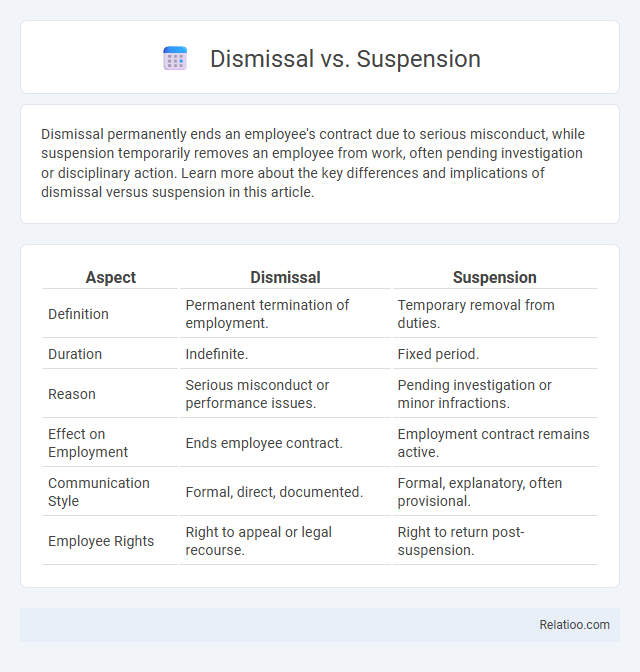Dismissal permanently ends an employee's contract due to serious misconduct, while suspension temporarily removes an employee from work, often pending investigation or disciplinary action. Learn more about the key differences and implications of dismissal versus suspension in this article.
Table of Comparison
| Aspect | Dismissal | Suspension |
|---|---|---|
| Definition | Permanent termination of employment. | Temporary removal from duties. |
| Duration | Indefinite. | Fixed period. |
| Reason | Serious misconduct or performance issues. | Pending investigation or minor infractions. |
| Effect on Employment | Ends employee contract. | Employment contract remains active. |
| Communication Style | Formal, direct, documented. | Formal, explanatory, often provisional. |
| Employee Rights | Right to appeal or legal recourse. | Right to return post-suspension. |
Understanding Dismissal and Suspension
Dismissal refers to the permanent termination of an employee's contract, often due to serious misconduct or poor performance, resulting in immediate loss of employment. Suspension is a temporary removal from duties, usually with pay, intended to investigate allegations or maintain workplace safety without making immediate employment status decisions. Understanding these distinctions is crucial for employers to ensure fair disciplinary actions and compliance with labor laws.
Key Differences Between Dismissal and Suspension
Dismissal refers to the permanent termination of an employee's contract, while suspension is a temporary removal from duties pending investigation or disciplinary action. Suspension maintains the employee's status and pay in most cases, whereas dismissal results in complete separation and loss of employment benefits. The key difference lies in the intent and duration: suspension is provisional and aims to preserve options, whereas dismissal is a final termination of employment.
Legal Definitions of Dismissal and Suspension
Dismissal refers to the termination of an employee's contract by the employer, often due to gross misconduct, poor performance, or redundancy, and is legally defined as the end of the employment relationship with or without notice depending on the severity of the cause. Suspension is a temporary removal of an employee from their duties, typically pending investigation of alleged misconduct or during disciplinary procedures, without terminating the employment contract. Legal definitions emphasize that dismissal results in permanent separation, while suspension maintains employment status but restricts work duties, often with or without pay based on jurisdictional labor laws.
Grounds for Employee Dismissal
Grounds for employee dismissal typically include gross misconduct, repeated violation of company policies, poor performance, or breaches of contract. Suspension serves as a temporary measure to investigate allegations or maintain workplace safety without immediately terminating employment. Unlike suspension or lesser disciplinary actions, dismissal results in the permanent termination of the employment contract due to justified reasons substantiated by evidence or legal compliance.
Common Reasons for Employee Suspension
Common reasons for employee suspension include violations of company policies, poor attendance, insubordination, and misconduct such as harassment or theft. Suspension serves as a temporary measure to investigate or penalize an employee's behavior without immediate termination. Understanding these causes helps you navigate the disciplinary process effectively, ensuring fair treatment and compliance with legal standards.
Procedural Steps in Dismissal
Procedural steps in dismissal require a clear, documented investigation followed by a formal meeting where You have the opportunity to respond to the allegations. An employer must provide written notice outlining the reasons for dismissal and any evidence gathered, ensuring compliance with labor laws. This process differs from suspension, which is typically a temporary measure pending investigation, and the distinction helps protect Your rights throughout employment termination.
Procedural Steps in Suspension
Suspension involves a temporary removal from duties, requiring a clear procedural process including formal notification of charges, an opportunity for You to respond, and adherence to company policies or unions agreements. The procedural steps in suspension ensure fairness and compliance by documented warnings and a defined duration, distinguishing it from outright dismissal, which is a permanent termination following a more rigorous investigation and final decision. Proper suspension protocols protect Your rights while maintaining workplace order during disciplinary reviews.
Implications for Employee Rights
Dismissal permanently terminates an employee's contract, often entitling them to severance pay and legal recourse if wrongful termination occurs, significantly impacting their right to continued employment. Suspension temporarily removes the employee from their duties, usually without pay or with pay, depending on company policy and labor law, preserving the employee's right to reinstatement upon investigation or resolution. Unlike dismissal, suspension serves as a disciplinary or investigative tool without ending employment, thereby maintaining certain employment benefits and protection against immediate job loss.
Impact on Employment Records
Dismissal results in a permanent negative mark on employment records, often affecting future job prospects and professional reputation. Suspension is typically recorded as a temporary disciplinary action, which may have less severe long-term consequences but still signals potential workplace issues. Reinstatement after suspension usually mitigates damage to the record, while dismissal frequently leads to formal documentation of termination reasons.
Choosing the Appropriate Disciplinary Action
Choosing the appropriate disciplinary action requires evaluating the severity and context of the employee's misconduct to determine whether dismissal, suspension, or other measures are justified. Suspension serves as a temporary removal that allows investigation while maintaining procedural fairness, whereas dismissal permanently ends employment due to serious breaches such as gross misconduct. Employers must consider company policies, legal regulations, and evidence to ensure the disciplinary action aligns with organizational standards and reduces the risk of wrongful termination claims.

Infographic: Dismissal vs Suspension
 relatioo.com
relatioo.com